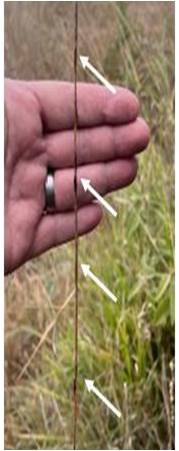Winter has arrived! This weekend saw us all clad in warm clothing, jackets, scarves, and beanies. All that is, except Luke, with his shorts, vellies and bush shirt. Temperatures at Potokwane camp dived overnight to some 3°C, and we saw frost on our early Sunday morning bush walk.
On Friday evening we wrote our Veld Management test at the Education Centre, starting in torch light due to loadshedding until the power come back on. Back at camp several of us were huddled around the campfire, but not for long, as Saturday required an early morning start. Sounds of elephant feeding and breaking branches outside the camp lulled us to sleep.
On Saturday morning we were at the Education Centre to listen to our incredibly knowledgeable and entertaining lecturer, Ulrich Oberprieler, who gave us insight into all facets of animal behaviour, including that of Homo sapiens. As a bonus, he demonstrated his ‘pet tin’ – providing evidence that with modern technology, even an inanimate abiotic object can be trained to respond when called!
There was a fairly long debate on the subject of altruism, which, according to Wikipedia is “the principle and moral practice of concern for the welfare and/or happiness of other human beings or animals, resulting in a quality of life both material and spiritual”, https://en.wikipedia.org/wiki/Altruism. Accessed 20230522.
After the lectures, each group was shown where their practical communications exercise would be taking place later in the year.
Back at camp we were challenged to identify the animals to which various teeth, skulls, scat and skin belonge. I bet those observing human behaviour were entertained by the not-so-quiet debates that emerged from the three groups. One team benefited greatly from Mollie’s dentistry knowledge, down to identifying the sex of the juvenile zebra skull, noting the extra 2 incisors behind the upper teeth of the African savanna hare, and even correctly identifying the tooth of a whale, cunningly put into the mix by Ulrich.
Each group was then squeezed into a car and directed into the park to find animals for the Ethology exercise. Teams were tasked with monitoring the various behaviours of a group of animals, which seemed strangely hard to find during this exercise! Even impalas were in short supply. Two groups settled on observing rhino activities, and the other group on a herd of impala. Strangely, the impala observations were way more complex and interesting than the consistent mowing of the veld by the White rhino. These now all belong in the same game viewing category as lions, and impalas have definitely attained a great deal more status.
We were introduced to the folks who were to guide us on the Sunday bush walk on Saturday evening and several stories were shared about past wildlife encounters whilst sitting around the campfire. These stories definitely did nothing to alleviate the uncertainty that some of us felt regarding our safety on the following morning’s walk. After a great deal of reassurance, supplemented with stern warnings to not talk (or try to outrun lions etc.) on the walk, we all toddled off to bed and a good night’s rest. Except for a couple of our team who were enjoying the warmth of the fire and chewing the cud on how best to fix a sole back onto the shoe (no names or brand names mentioned). Zzzz!
Come Sunday morning, the entire group appeared to have transformed into a small army! Everyone was in either khaki, camouflage or greens and beige. Quite a transformation! We were given instructions on how the walks would be conducted, with one armed guide in the front of the group, and another at the back of the walkers. We packed into as few cars as possible (to keep warm) and headed off to Malatse Dam which was the start of our walk. Team 1 members determined that all the juniors were in Team 2, and that Jeremy had placed all the > 50’s in Team 1, other than Rebecca.
Team 1’s trail headed northwards into the wilderness area and into a place of peace and quiet. No signs of anthropogenic activity, just us and the bush smell, sights, spoor and sounds. There were so many tracks on the paths because of the recent rains, and it was astonishing to see how many elephants had been in the area. Let alone lions. There were some great deep lion spoor in places, and we also identified steenbok, impala, and rhino tracks. The dead rat, still warm had us puzzled; we had probably disturbed a jackal or small cat which left in a hurry.
We were able to identify other animal species from their scat and middens, led ably by resident “spoorman”, Johan. Very white scat (due to its high calcium content) indicated a hyena latrine site, confirmed by the unique, and apparently smelly and very telling pastings found on a nearby grass stalk.
Just after this, a lone tree (Peltophorum africanum) on the saddle of the hill held some surprises for us. Fresh leopard dung on the tree branch and a beautiful death’s head hawk-moth, (Acherontia Atropos). This large, common moth raids beehives for honey, and can squeak through its proboscis (Picker, M., Griffiths, C., and Weaving, A. 2002, Field Guide to Insects. Struik, 445pp). The markings on the thorax (which are incidentally skull-like) apparently deter would be predators.
All in all, it was an extremely interesting weekend. Observing both animal and human behaviour was fascinating.
Ed’s Note: Thanks so much to team Wetlands – Lampies, Rebecca, Jacques, Sarel and Michele, for this very interesting feedback from the weekend.




